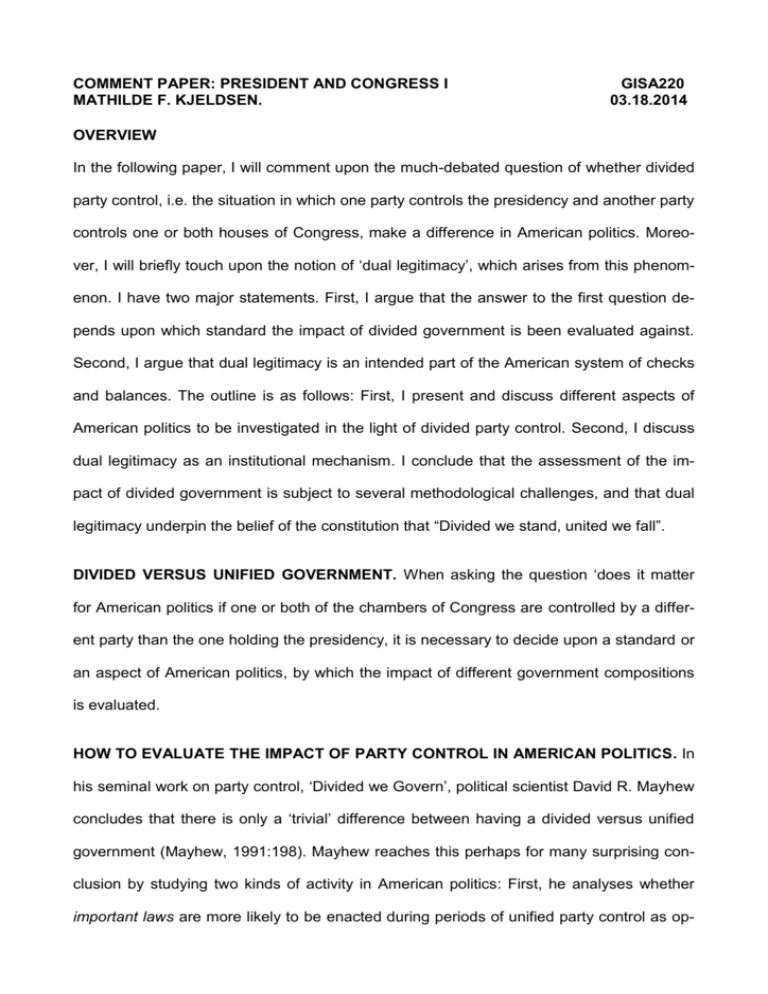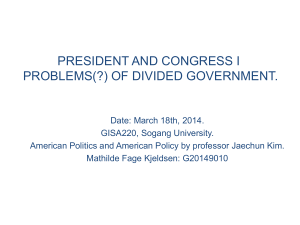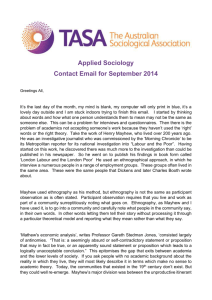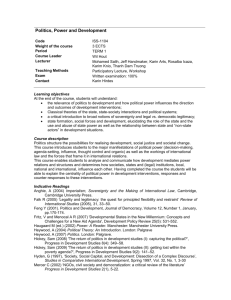COMMENT PAPER: PRESIDENT AND CONGRESS I GISA220
advertisement

COMMENT PAPER: PRESIDENT AND CONGRESS I MATHILDE F. KJELDSEN. GISA220 03.18.2014 OVERVIEW In the following paper, I will comment upon the much-debated question of whether divided party control, i.e. the situation in which one party controls the presidency and another party controls one or both houses of Congress, make a difference in American politics. Moreover, I will briefly touch upon the notion of ‘dual legitimacy’, which arises from this phenomenon. I have two major statements. First, I argue that the answer to the first question depends upon which standard the impact of divided government is been evaluated against. Second, I argue that dual legitimacy is an intended part of the American system of checks and balances. The outline is as follows: First, I present and discuss different aspects of American politics to be investigated in the light of divided party control. Second, I discuss dual legitimacy as an institutional mechanism. I conclude that the assessment of the impact of divided government is subject to several methodological challenges, and that dual legitimacy underpin the belief of the constitution that “Divided we stand, united we fall”. DIVIDED VERSUS UNIFIED GOVERNMENT. When asking the question ‘does it matter for American politics if one or both of the chambers of Congress are controlled by a different party than the one holding the presidency, it is necessary to decide upon a standard or an aspect of American politics, by which the impact of different government compositions is evaluated. HOW TO EVALUATE THE IMPACT OF PARTY CONTROL IN AMERICAN POLITICS. In his seminal work on party control, ‘Divided we Govern’, political scientist David R. Mayhew concludes that there is only a ‘trivial’ difference between having a divided versus unified government (Mayhew, 1991:198). Mayhew reaches this perhaps for many surprising conclusion by studying two kinds of activity in American politics: First, he analyses whether important laws are more likely to be enacted during periods of unified party control as op- posed to periods of divided party control. In other words, he investigates if unified governments are more productive than divided governments. Indeed, it seems logically, having both the White House and the majority in Congress, that more significant public policy is produced. Second, he analyses whether divided party control results in more congressional oversight or congressional investigation of the executive branch and the bureaucracy. Again, this seems likely when considering the divergent policy preferences of the parties. But, as already revealed, Mayhew finds no clear evidence in support of the above hypotheses. In short, he concludes that the enactments of important laws are correlated with the presidential period cycle and with the public opinion (Mayhew, 1991: 177). At first, it seems difficult to challenge his conclusions, as he presents strong evidence in favour of his case with an impressive empirical analysis spanning from 1946-1990 as well as across many policy areas. I would like to give it a try, though, as a broadly recognized truth in the field of political science is that the aspects or activities we chose to focus on determines our conclusions. Having conducted no empirical research on the subject, I would in the following discuss other activities in American politics than those studied by Mayhew, where there could be different consequences of having divided or unified party control. Table 1: Aspects of American politic influenced by divided party control. Aspect Example Inter-branch dynamics: The question of process vs. product-related consequences. The enacted legislation The discussion of motion or productivity vs. direction or content The administrative implementation process. The question of congressional oversight Accountability The question of who are responsible for the enacted laws. Negotiation Deadlock/veto Larger reform bills Compromises Delegation of power Oversight Blame and credit First, I would like to point attention to the question of party control and inter-branch dynamics. The two kinds of activity studied by Mayhew are outcome-related activity (Kelly, 1993). Another approach could be to look at the political process e.g. at the consequences for the inter-branch decision making dynamics (see also Krehbiel, 1996:7). Divided party control yield different ways to go around politics when compared to a unified government. In such circumstances, Congress and the presidency are forced to engage in a political process of bargaining and negotiation. As no party has majority in both branches, and because of the American institutional system of checks and balances, this is the only way to make policy. The increased (forced) bargaining can have different more or less desirable consequences. One is the possibility of deadlock or the prevail of status quo, where no considerable policy changes are enacted. This is the case when Congress itself (should the House and the Senate be controlled by different parties), or when Congress and the presidency cannot reach agreement. The potential result of divided government is on the one hand a rigid system without major changes in legislation, and with the risk or gridlock or even government shutdown (seen as recent as in 2013). On the other hand, the periods of divided could be characterized be a deliberation-based and compromise-seeking political process. Though negotiation may be more pronounced during divided party control, this does not necessarily imply a more constructive political process as illustrated by the historically use of the presidential veto power. This is much more pronounced during divided government (Lowi, 2010: 239). By this, the question of government efficiency comes to mind. In one way, deadlock and veto powering is an expression of checks and balances, and thereby not always just the result of stubborn politicians. From another perspective, in a system where it is almost impossible to pass legislation, it can seem problematic that so much time and resources are put into the political process. Either way, where does these tendencies leave American politics? Can the constitutional concern about the misuse of power really legitimatise such a rigid system? Second, is the above really the whole truth? Does divided government not bring about any legislation that is not just an insignificant change from status quo? According to Niskanen (2003), the answer is yes. Instead of focusing on the consequences for the dynamics in the political process, one could instead take a look at the content of the legislation that passes. An advantage to the tension between the governmental branches is that those reforms that are enacted are more likely to last instead of being reversed, when a new majority emerge. As law-making during times of divided government requires bipartisan support, a shift in majorities is less likely to bring on serious changes or alterations (Niskanen, 2003) as opposed to shifts between unified governments. This tendency is often seen in the Danish political system, where new parliamentary majorities constantly changes or pull back reforms enacted by prior coalitions. Another (positive) consequence of the negotiation and bargaining is that the enacted legislation is more inclusive. The more negotiations a bill has to go through the higher is the likelihood that it is revised in a manner so it is broader. In this way, the distributive content must be expected to increase, spreading the beneficiaries of the law to include a wider group (Lowi, 2010). One could agree on this, but point to the fact that compromises often miss to benefit those most in need, and that drastic changes are difficult to agree upon. A recent example is the case of Obamacare. Third, which impact does divided government have on the bureaucracy? A much-debated issue among scholars is the question of whether laws enacted by the legislature are faithfully implemented by the executive and the bureaucracy. There is broad academic consensus about that policy is no more than an empty abstraction before it gets implemented (Moe, 1990). Therefore, oversight is needed, either actively or through institutional mechanisms, to ensure that the laws are enacted in accordance with their purposes. The potential agency loss is, all else being equal, greater during divided government, as the president - the chief of the administration (at least in many instances) - have the power to intervene into the implementation process by giving executive orders. As the enacted laws are often vague due to the difficulty of reaching agreement, this leave a lot of discretion – and thereby power – in the hands of those who controls the implementation process. In the same line of argument, according to Lowi (2010), Congress is less inclined to delegate powers to the president in times of divided party control, as the policy preference gap, and therefore agency loss, can be great. In this perspective, Congress spends a lot of resources and time on keeping control with the bureaucracy or deals with tasks itself, which it in times of unified government would have delegated elsewhere. Fourth, and finally, the consequences of divided government for the public’s ability to place responsibility – both credit and blame – are relevant to briefly comment upon. As the president do not have the majority to pass legislation on his own, he needs to gain bipartisan support. In return, the opposing party (of course) wants to claim credit for successful and popular legislation. This is not a huge problem (except perhaps for reelection-orientated politicians). The problem arises when things go wrong. Who are to blame? The president? Congress? Both? None? This can be difficult to figure out, and the chain of accountability becomes blurred. This has serious democratic consequences as it becomes impossible for the voters to evaluate the performance of their representatives, and thereby exercise their constitutional power over the government. DUAL LEGITIMACY – A PROUD PRODUCT OF THE CONSTITUTION. The issue of dual legitimacy arises during divided government as both the president as well as Congress can claim to speak in the name of the people. At first, divided government might seem to indicate an irrational voting behaviour by the people or by contemporary political tendencies as the decline in partisanship and voter trust. But perhaps this is not the (only) thing behind the appearance of divided government and thus dual legitimacy. Thinking back on James Madison and the Federalist papers, this situation must be exactly what was intended behind the Constitution and the separation of power. Dual legitimacy offers a guarantee to the people that the government would be of no threat to them, and is a component to ensure liberal democracy. The original thought behind separating the power of government into three branches of government was made to avoid concentration of power. By also giving the different branches separate constituencies, thereby making the situation of divided government possible, it was ensured that each branch has different perspectives on the public interest as they have different demands to serve. By such, dual legitimacy ensures constant competition between the Democrats and the Republicans at many different levels. In this way, dual legitimacy has a connection with the thought of federalism as the different constituencies ensures that the politicians give thought to not only national needs, but also state and local wants. CONCLUSION “Ambition must be made to counteract ambition”, James Madison wrote in Federalist paper #51. Divided party control, an institutional arrangement arising from the separate popular elections for the government branches, ensures this for good and bad. This paper has argued that whether or not divided government make a difference depends upon which aspects of American politics that is studied, and, contrary to the conclusion of Mayhew, concludes that it does make a difference in several instances. REFERENCES Kelly, Q. Sean (1993). Divided we govern? A Reassesment. Vol.25. No 3 (Spring, 1993). Pp. 475-484. Palgrave Macmillan Journals. Krehbiel, Keith (1996). Institutional and partisan sources of gridlock. A theory of divided and unified government. Journal of Theoretical Politics 8(1). Sage publications. Lowi, Theodore J., et al, American Government: Power and Purpose, 10th edition, New York, W. W. Norton & Company, 2004. Mayhew, David R. (1991). Divided we govern. Party control, lawmaking, and investigations 1946-1990. Vail-Ballou Press, New York. • Moe, Terry M. (2012). “Delegation, Control, and the Study of Public Bureaucracy”, The Forum 10, Iss. 2: Article 4 • Niskanen, William A (2003). A Case for Divided Government. A commentary. Cato Institute. http://www.cato.org/publications/commentary/case-divided-government • http://en.wikipedia.org/wiki/113th_United_States_Congress







